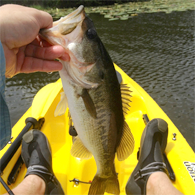
Some of the most fun that can be had from a kayak is hooking into a Tarpon. They are incredibly strong, put on an acrobatic areal show and are one of the most challenging fish to land. The Mosquito Lagoon offers kayak anglers an opportunity to hook into a small to medium sized tarpon on the open grass flats.
Equipment for Catching Tarpon
The Tarpon that are found on the grass flats of the Mosquito Lagoon range from about five pounds up to well over fifty pounds with the most common tarpon found ranging from 10-25 pounds. Tarpon are quite strong and agile fish, so the equipment used to catch them has to be able to handle the battle that will ensue.
A spinning outfit is the most common and most preferred when fishing for tarpon on the flats. A reel that can hold up to 15lb braided line, has a strong and smooth drag, and enough torque to pull a large fish is required. The rod should be matched to the reel, with a strong back bone and a medium action tip to allow strong hook sets. 15lb braided line allows for the long casts that are often necessary and it is also highly abrasion resistant. Tip the braided line off with a 20-24 inch leader of 20lb fluorocarbon line, this leader will add strength and is nearly invisible in the water.
When to Find Tarpon
Tarpon are warm water fish that are highly migratory. They are normally only found in Mosquito Lagoon during the summer and early fall months. On an average year they will start showing up in the lagoon around June/July and stay until around September. Warmer years the move in sooner, colder years they move in later.
Where to Find Tarpon
Tarpon can be found throughout Mosquito Lagoon. They are found in the deep shipping channel, the shallow grass flats and around the mangrove shore lines. The larger fish are almost exclusivly found near the channels while the small to medium fish are found just about anywhere.
How to Catch Tarpon
Live Bait
Tarpon are very active fish when they are in the Mosquito Lagoon. They do not often stay in one place, so soaking a bait on the bottom is not one of the best techniques for catching these exciting fish.
The best technique with life bait is to paddle around areas known to hold tarpon. The fish are easy to spot when they are in the area because of their “rolling” behavior. When a fish, or multiple fish are spotted, cast a free-lined bait on a 4-6/0 circle hook about 5 yards ahead of the direction the fish are moving. If the bait is not taken when the Tarpon swim by, reel it in, paddle ahead of them and try again.
After a fish takes the bait, reel in any slack. Once pressure is felt pull with a firm, but not too fast motion to the side to set the hook. Tarpon will often go airborne right away, so be aware of what direction your rod tip is facing and make sure not to allow the fish any slack or the hook will come lose and the fish will swim free.
Artificial Lures
Tarpon are willing strikers of artificial lures, making them one of the most fun fish to catch on Mosquito Lagoon’s flats. To catch them on a lure, locate a fish, or a school of fish, and cast the lure about 2 yards ahead of where the fish is heading. Work the lure in an erratic fashion (emulating an injured forage item for the Tarpon) and use a STRONG hook set once a hit is detected.
Do not be overly discouraged if a Tarpon comes off the hook before it is landed. This is VERY common. These fish are one of the most difficult to land because of their hard mouths and acrobatics once hooked.
Some of the best lures for Tarpon are:
- Walk-The-Dog Topwater Lures
- Large Curl Tail Grubs
- Jerk Baits
- Large Shrimp Imitations
- Any lure that resembles a mullet or pinfish
Florida Tarpon Regulations (accurate as of August 2015)
- Catch and Release only (with the exception of those that hold a Tarpon tag)
- Tarpon over 40 inches must remain in the water at all times (never allowed to be pulled out of water, even for a picture)
- Tarpon under 40 inches are allowed to be pulled out of the water for pictures only.


Comment here